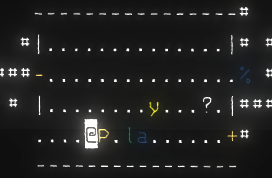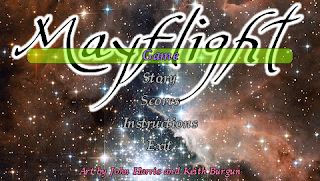 My secret project, a procedural exploratory game for YoYoGames' summer competition, is ready to show the world. It is called Mayflight. It's kind of relevant here because I used some roguelike design principles in its making, especially in creating its huge game world and your character's ability set. (I can't post it on Metafilter Projects yet because it's been too soon since my post of my most recent Gamasutra article. I seem to be using Projects rather a lot lately....)
My secret project, a procedural exploratory game for YoYoGames' summer competition, is ready to show the world. It is called Mayflight. It's kind of relevant here because I used some roguelike design principles in its making, especially in creating its huge game world and your character's ability set. (I can't post it on Metafilter Projects yet because it's been too soon since my post of my most recent Gamasutra article. I seem to be using Projects rather a lot lately....)
It's sort of like a Metroidvania in some ways. It is a platformer, and you explore a big mappable space looking for powerups and fighting monsters. However, it has no end. The game world is randomly created every game, and has no edges. Exploring out several areas, bring up the map and zooming out, then seeing the trail of blue rooms extending off-screen is kind of fascinating.

Also, the powerup/map dynamic isn't the Russian nesting doll setup of ever-increasing exploration spheres made available by finding new equipment. Instead your character, Aurora the fairy, is weak in ability at the start, but becomes stronger generally in various areas by finding powerups.
 Because there's no end to the world, and the powerups increase ability rather than grant new ones, the point of the game changes. There is a time limit, and the idea is to go as far as you can during it. Although it starts at only ten seconds, you can extend it continually by finding "sparks," which are scattered around with the ubiquity of Mario's coins. The game is played for high score. The two scores provided are raw distance from the starting location upon death, and a more traditional score that generally measures playing ability and accomplishment.
Because there's no end to the world, and the powerups increase ability rather than grant new ones, the point of the game changes. There is a time limit, and the idea is to go as far as you can during it. Although it starts at only ten seconds, you can extend it continually by finding "sparks," which are scattered around with the ubiquity of Mario's coins. The game is played for high score. The two scores provided are raw distance from the starting location upon death, and a more traditional score that generally measures playing ability and accomplishment. Playing it, it seems to have a nice balance to me. The monsters are challenging without being overwhelming (at least not until you have had a chance to power up), the constant need to extend your lifespan means there is little downtime, and it's challenging while possible to survive for more than an hour with good play. I was even able to squeeze a couple of covert pinball references into the game's interface. I'm particularly proud of the background generator, which is able to produce a wide variety of interesting dynamically-generated looks for areas for relatively little processor time. I post some of the more interesting screens here.
Playing it, it seems to have a nice balance to me. The monsters are challenging without being overwhelming (at least not until you have had a chance to power up), the constant need to extend your lifespan means there is little downtime, and it's challenging while possible to survive for more than an hour with good play. I was even able to squeeze a couple of covert pinball references into the game's interface. I'm particularly proud of the background generator, which is able to produce a wide variety of interesting dynamically-generated looks for areas for relatively little processor time. I post some of the more interesting screens here.
Anyway, now that Mayflight has seen a public release I can focus more on @Play. The next column or two will probably discuss the game as an example of roguelile design principles applied to a very non-roguelike kind of game. Then we'll probably get back to the usual beat. In particular, Dungeon Crawl has seen a lot of development effort lately, having jumped another whole version number in the past two months!
More screens from Mayflight:












No comments:
Post a Comment
Note: Only a member of this blog may post a comment.